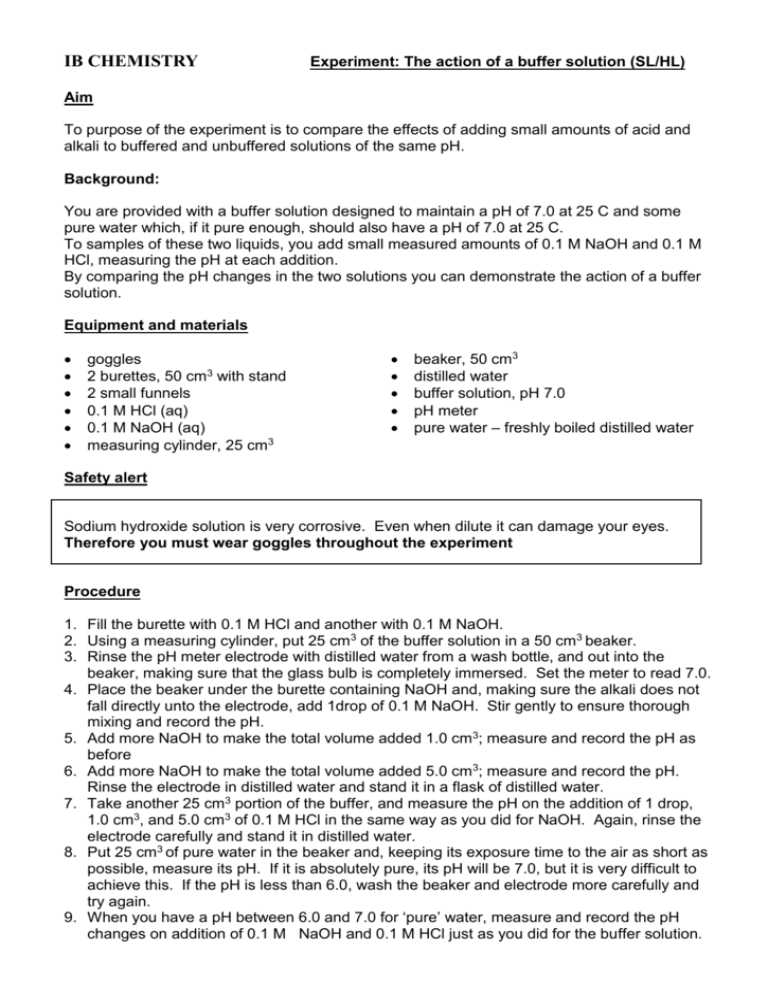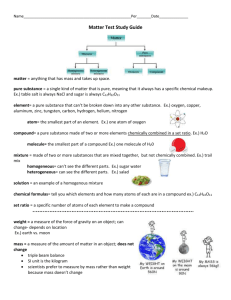Topic 18 action of buffer
advertisement

IB CHEMISTRY Experiment: The action of a buffer solution (SL/HL) Aim To purpose of the experiment is to compare the effects of adding small amounts of acid and alkali to buffered and unbuffered solutions of the same pH. Background: You are provided with a buffer solution designed to maintain a pH of 7.0 at 25 C and some pure water which, if it pure enough, should also have a pH of 7.0 at 25 C. To samples of these two liquids, you add small measured amounts of 0.1 M NaOH and 0.1 M HCl, measuring the pH at each addition. By comparing the pH changes in the two solutions you can demonstrate the action of a buffer solution. Equipment and materials goggles 2 burettes, 50 cm3 with stand 2 small funnels 0.1 M HCl (aq) 0.1 M NaOH (aq) measuring cylinder, 25 cm3 beaker, 50 cm3 distilled water buffer solution, pH 7.0 pH meter pure water – freshly boiled distilled water Safety alert Sodium hydroxide solution is very corrosive. Even when dilute it can damage your eyes. Therefore you must wear goggles throughout the experiment Procedure 1. Fill the burette with 0.1 M HCl and another with 0.1 M NaOH. 2. Using a measuring cylinder, put 25 cm3 of the buffer solution in a 50 cm3 beaker. 3. Rinse the pH meter electrode with distilled water from a wash bottle, and out into the beaker, making sure that the glass bulb is completely immersed. Set the meter to read 7.0. 4. Place the beaker under the burette containing NaOH and, making sure the alkali does not fall directly unto the electrode, add 1drop of 0.1 M NaOH. Stir gently to ensure thorough mixing and record the pH. 5. Add more NaOH to make the total volume added 1.0 cm 3; measure and record the pH as before 6. Add more NaOH to make the total volume added 5.0 cm 3; measure and record the pH. Rinse the electrode in distilled water and stand it in a flask of distilled water. 7. Take another 25 cm3 portion of the buffer, and measure the pH on the addition of 1 drop, 1.0 cm3, and 5.0 cm3 of 0.1 M HCl in the same way as you did for NaOH. Again, rinse the electrode carefully and stand it in distilled water. 8. Put 25 cm3 of pure water in the beaker and, keeping its exposure time to the air as short as possible, measure its pH. If it is absolutely pure, its pH will be 7.0, but it is very difficult to achieve this. If the pH is less than 6.0, wash the beaker and electrode more carefully and try again. 9. When you have a pH between 6.0 and 7.0 for ‘pure’ water, measure and record the pH changes on addition of 0.1 M NaOH and 0.1 M HCl just as you did for the buffer solution. Take special care to wash to the electrode when you change from using alkali to acid. Record you results. 10. Take another 25 cm3 of pure water, measure the pH and then leave it to stand open to the air for 10 minutes. Measure the pH again and record the results. Results table Volume added pH on addition of 0.1 M NaOH to Buffer 0 1 drop 1.0 cm3 5.0 cm3 pH of pure water with minimum air exposure pH of pure water after 10 minutes of air exposure Pure water pH on addition 0.1 M HCl to Buffer Pure water





